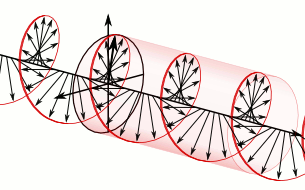Everything which happens around us is a result of the interaction of forces and we mean everything, from a fruit falling from a tree (remember Isaac Newton?) to Earth orbiting around the Sun, aa matter around us interacts with other bodies around it, This phenomenon is based on four fundamental forces.
Gravity, the weakest of the four natural forces is present in our everyday lives. It determines how and why things around us stay at a certain height and why some objects fall down, while others take longer.
Electromagnetic forces run our electric and digital machines and allow us to access the universe from the comfort of our homes.
The other two natural forces, namely the strong and the weak nuclear forces, operate at the atomic level. They influence the fundamental particles of an atom including the proton and electrons.
Each of the four fundamental forces of nature has unique properties and characteristics. Every single interaction which takes place in the universe can be explained through these forces. However, there are certain interactions that appear to be bizarre and are not explained by these four forces. This raises the question of the existence of a fifth, unknown and unexplained force of nature. Physicists are still struggling to find the answer.
Gravity

If a pen slips out of your hand, it will immediately fall down and touch the ground. For humans, gravity appears to be the strongest and most obvious force of nature. In reality, gravity is actually the weakest of the four elements, at least on this planet. It’s a whole different animal in outer space.
Simply defined, gravity is the attraction between any two objects which have a mass. The force depends upon the mass of the objects. According to the law of gravitation, the magnitude or intensity of the gravitational force can be calculated by multiplying the masses with the universal gravitational constant ‘G’. The resultant is then divided by the square of the distance between the centers of the masses. There is a different force of gravity constant for each object in the solar system and for that matter, the universe. The formula is F = G*m1*m2/r2 . One example would be the force of gravity on Earth is 9.8 meters per second squared or 9.8 m/s2.
Gravity is very weak on the atomic level, but since most objects around us have so much mass, the force of gravity becomes stronger and more apparent. The force becomes stronger and more evident for universal objects with larger masses including the planets and stars. In this case, gravity is strong enough to keep them in an orbit. When it comes to galaxies, the mass further increases and gravity plays a crucial role in attracting galaxies even when they are far apart.
The Weak Nuclear Force
The weak nuclear force is much stronger than the gravitational force (1010 times). However, the force is only stronger within a certain range. It acts at a distance within the size of the proton. The particles which carry the weak nuclear force are called the weak vector bosons and have symbols w+, w-, and z0. The interaction between these particles causes one type of charged particle to turn into another type of charged particle. This interaction is responsible for phenomena such as beta and other radioactive decay.
Electromagnetic Force

The electromagnetic force, also known as magnetism is far stronger than the gravitational pull and has a much wider range than the weak nuclear force. It easily overrides gravity and it the third strongest force of nature is 1040 times stronger than the gravitational force.
An easy way to assess the strength of the electromagnetic force is to hold a magnet against a few paper clips. Gravity will attract the paper clips downwards but the electromagnetic force, which is stronger than gravity, will end up attracting the paper clips upwards.
The electromagnetic force allows the interaction of particles with an electric charge. When the charged particles are at rest, they interact through electrostatic forces. When in motion, they mingle together through both electrical and magnetic forces.
Though less powerful than the strong nuclear force, the electromagnetic force is by far the most prevalent force in the world. It can affect objects with a fair amount of power when they are at a reasonable distance.

The Strong Nuclear Force
The strong nuclear force is the strongest fundamental force of nature. It is the biggest influence on the fundamental particles of the universe. It is this force that binds together the nuclei of the atom. However, the range of the strong nuclear force is only limited to subatomic particles.
The nuclei of an atom are made up of a positively charged proton and a neutral charged neutron. Since like charges repel, each proton in the nuclei is working hard to get away from the other proton. This is where the strong nuclear force comes in. The strong force allows particles called gluons to stick together and create nucleons. These gluons can interact with other gluons and further strengthen the bond within the nuclei. The presence of a strong nuclear force is the reason why so much energy is released when the nuclei of an atom break down.
The Fifth Force – Fact or Fiction
Physicists around the world have unanimously agreed that the four fundamental forces explain every phenomenon (that we know of) in the universe. However, there are various mysteries of physics that cannot be explained by these four fundamental forces of nature.
One such mystery is the existence of dark matter. After immense research, physicists have agreed that dark matter is a form of a stable and huge particle that experiences gravity but no other known forces. Researchers have failed to identify the reason why dark matter does not experience any force other than gravity.
There are many ideas about why other forces do not act on dark matter. One famous hypothesis is the presence of an unidentified fifth force. Physicists around the world are studying the possibilities of the existence of a fifth fundamental force of nature. But it is too early to claim its presence.
